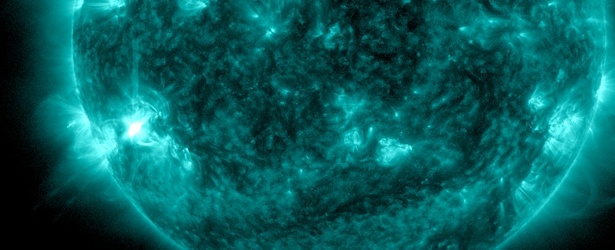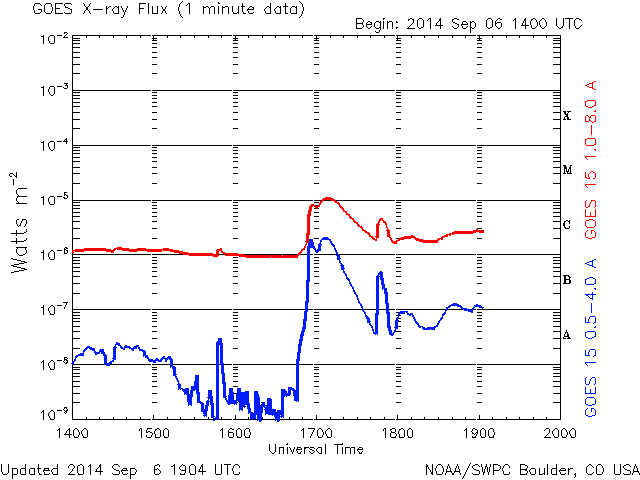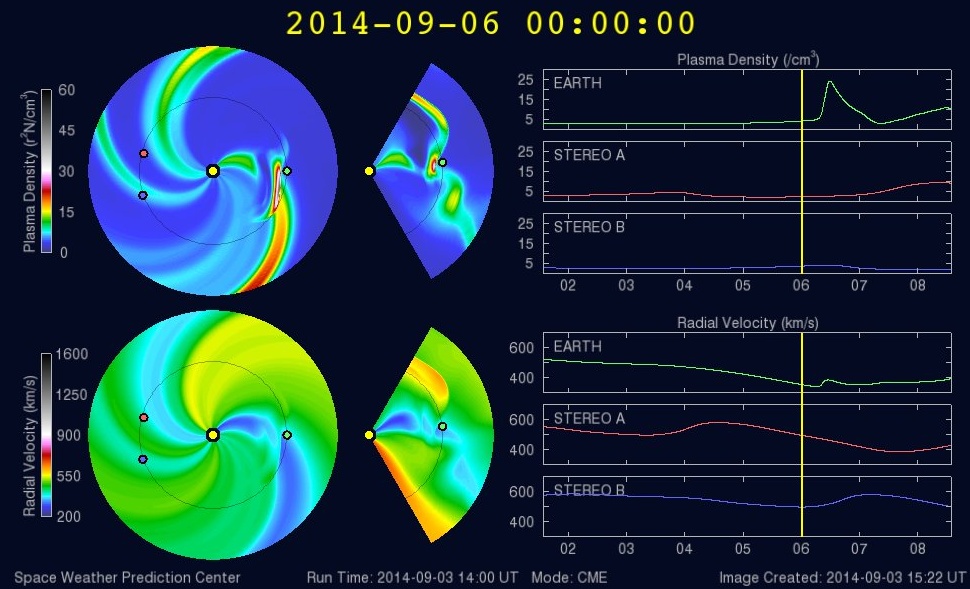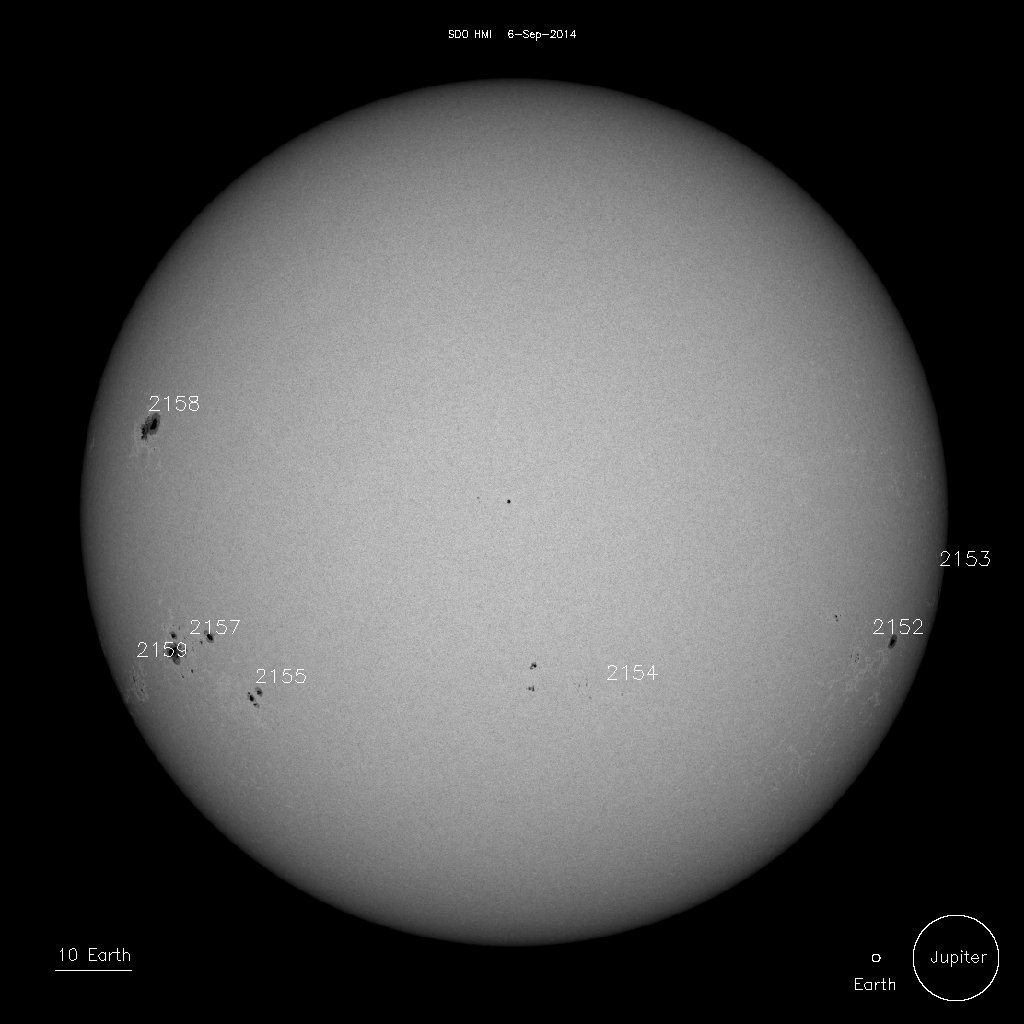Moderate M1.1 solar flare erupted from Region 2157

Active Region 2157 unleashed M1.1 solar flare on September 6, 2014. The event started at 16:50, peaked at 17:09 and ended at 17:22 UTC.
This region is located in the southeast quadrant and has 'beta-gamma-delta' magnetic configuration (capable of producing strong to major eruptions on the Sun). Although its location is still not favorable for Earth directed Coronal Mass Ejections (CMEs) this will change in the coming days as the region rotates into more geoeffective position.
NOAA SWPC forecasters estimate 55% chance for M-class and 15% chance for X-class solar flares in the next two days. The most likely sources for significant flare production are Regions 2157 and 2158.

Incoming CME
CME unleashed by plasma filament eruption on September 2 reached our planet around 15:25 UTC today. Minor (G1) geomagnetic storming is expected from this glancing blow.
High-latitude sky watchers should be alert for auroras.
 ***
***
Space Weather Message Code: SUMSUD
Serial Number: 197
Issue Time: 2014 Sep 06 1545 UTC
SUMMARY: Geomagnetic Sudden Impulse
Observed: 2014 Sep 06 1525 UTC
Deviation: 63 nT
Station: College
***
Space Weather Message Code: WARK04
Serial Number: 2311
Issue Time: 2014 Sep 06 1702 UTC
WARNING: Geomagnetic K-index of 4 expected
Valid From: 2014 Sep 06 1700 UTC
Valid To: 2014 Sep 07 1700 UTC
Warning Condition: Onset
Potential Impacts: Area of impact primarily poleward of 65 degrees Geomagnetic Latitude.
Induced Currents – Weak power grid fluctuations can occur.
Aurora – Aurora may be visible at high latitudes such as Canada and Alaska.
***
Space Weather Message Code: WATA20
Serial Number: 582
Issue Time: 2014 Sep 06 1946 UTC
WATCH: Geomagnetic Storm Category G1 Predicted
Highest Storm Level Predicted by Day:
Sep 06: G1 (Minor) Sep 07: G1 (Minor) Sep 08: None (Below G1)
THIS SUPERSEDES ANY/ALL PRIOR WATCHES IN EFFECT
Potential Impacts: Area of impact primarily poleward of 60 degrees Geomagnetic Latitude.
Induced Currents – Weak power grid fluctuations can occur.
Spacecraft – Minor impact on satellite operations possible.
Aurora – Aurora may be visible at high latitudes, i.e., northern tier of the U.S. such as northern Michigan and Maine.
Sunspots
There are currently 8 numbered sunspot regions on the disk.
Slight growth was observed in Region 2157 (source of todays M1.1 flare) as well as Region 2158 (N15E61, Dkc/beta-delta). Region 2157 has a well defined delta running in a SE-NW orientation through the lower half of the spot group. Region 2158 appears to have a reverse polarity delta splitting the compact spot group almost directly through the center running approximately N-S.

Sunspots on September 6, 2014. Image credit: NASA / SDO HMI
2151 – Alpha
2152 – Beta-Gamma
2153 – Beta
2154 – Beta
2155 – Beta
2157 – Beta-Gamma-Delta
2158 – Beta
2159 – Beta
Featured image: NASA / SDO AIA 131

Commenting rules and guidelines
We value the thoughts and opinions of our readers and welcome healthy discussions on our website. In order to maintain a respectful and positive community, we ask that all commenters follow these rules:
We reserve the right to remove any comments that violate these rules. By commenting on our website, you agree to abide by these guidelines. Thank you for helping to create a positive and welcoming environment for all.